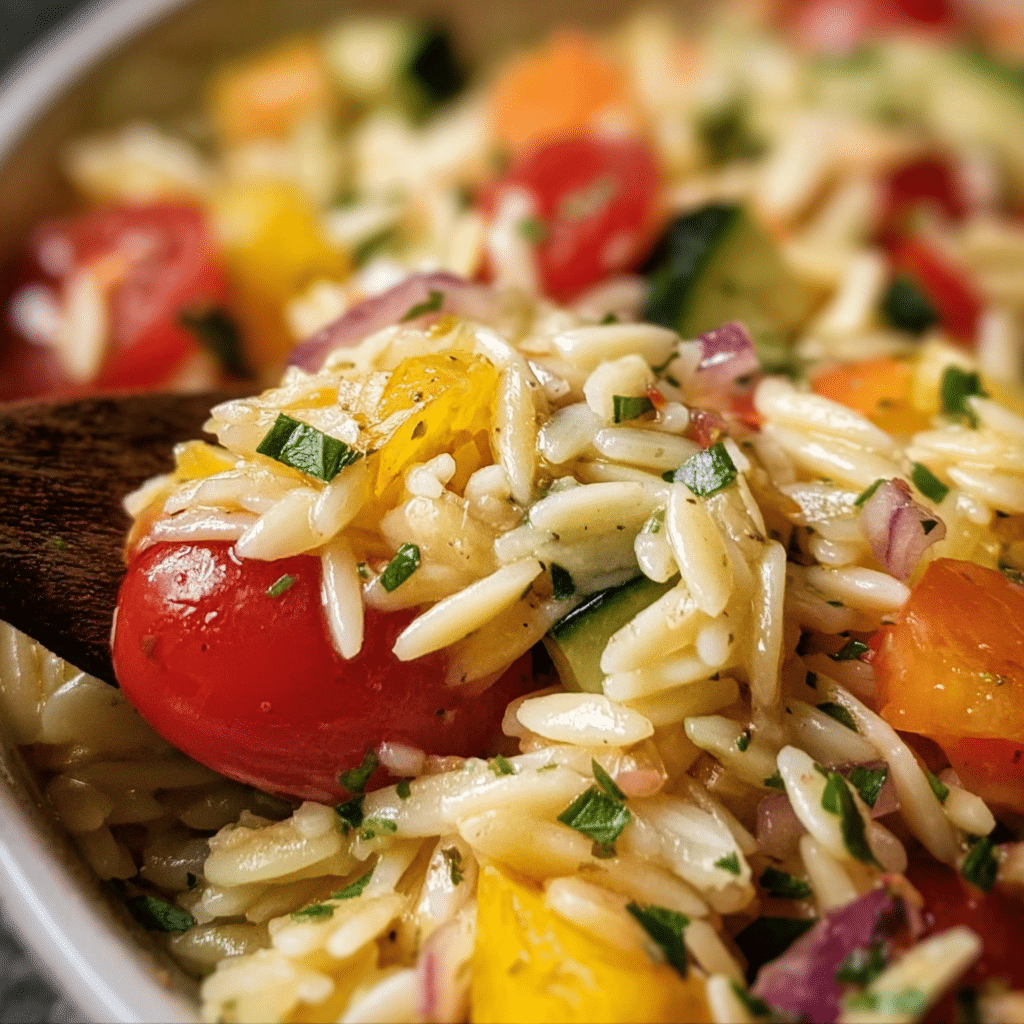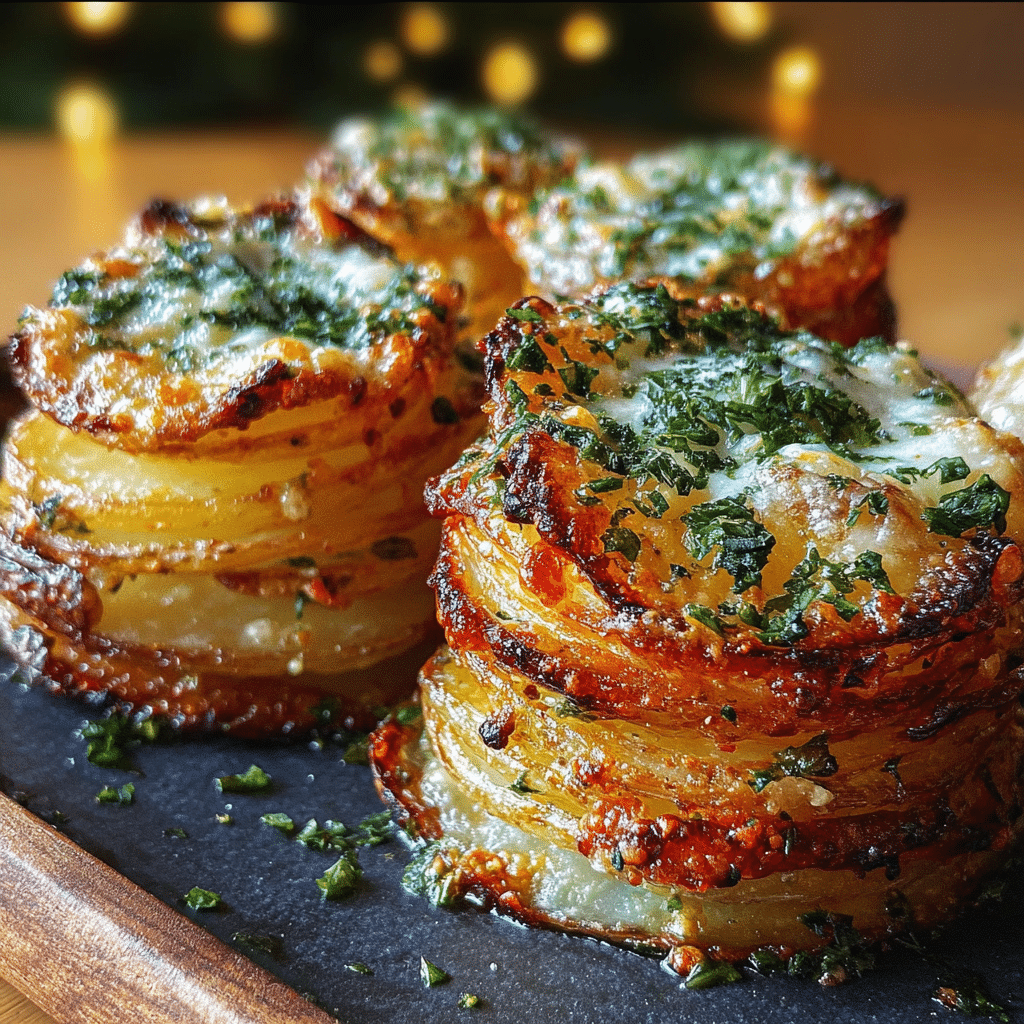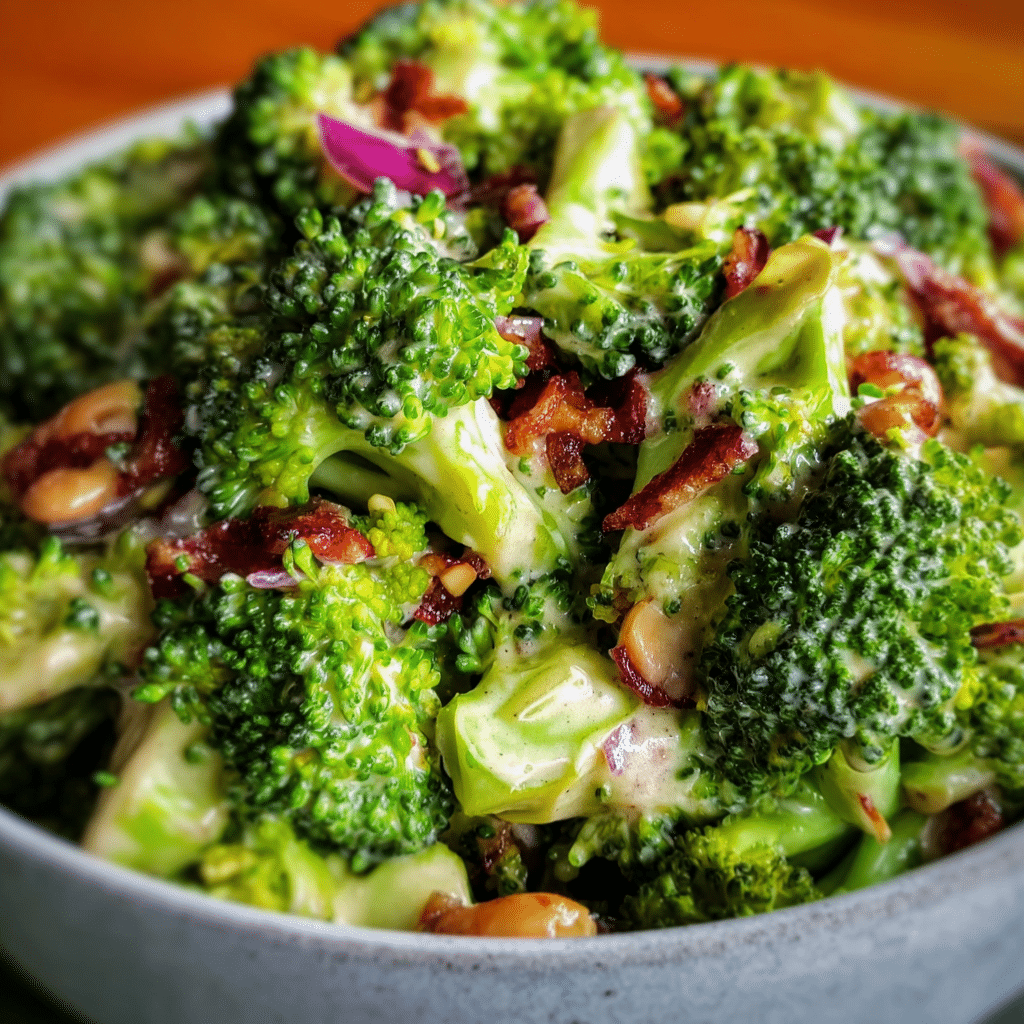Butternut squash feta is more than just a salad; it’s a culinary experience that brings warmth and comfort to any gathering. I still remember the first time I stumbled upon this delightful combination. It was a crisp autumn afternoon, and I was wandering through my local farmer’s market, captivated by the vibrant colors of the seasonal produce. The butternut squash stood out with its rich, golden hue, and I felt an urge to create something magical. As I browsed through various stalls, I found a vendor selling homemade feta cheese, its creamy texture and tangy flavor calling out to me. That day, the idea of butternut squash feta was born, and little did I know, it would become a staple in my kitchen.
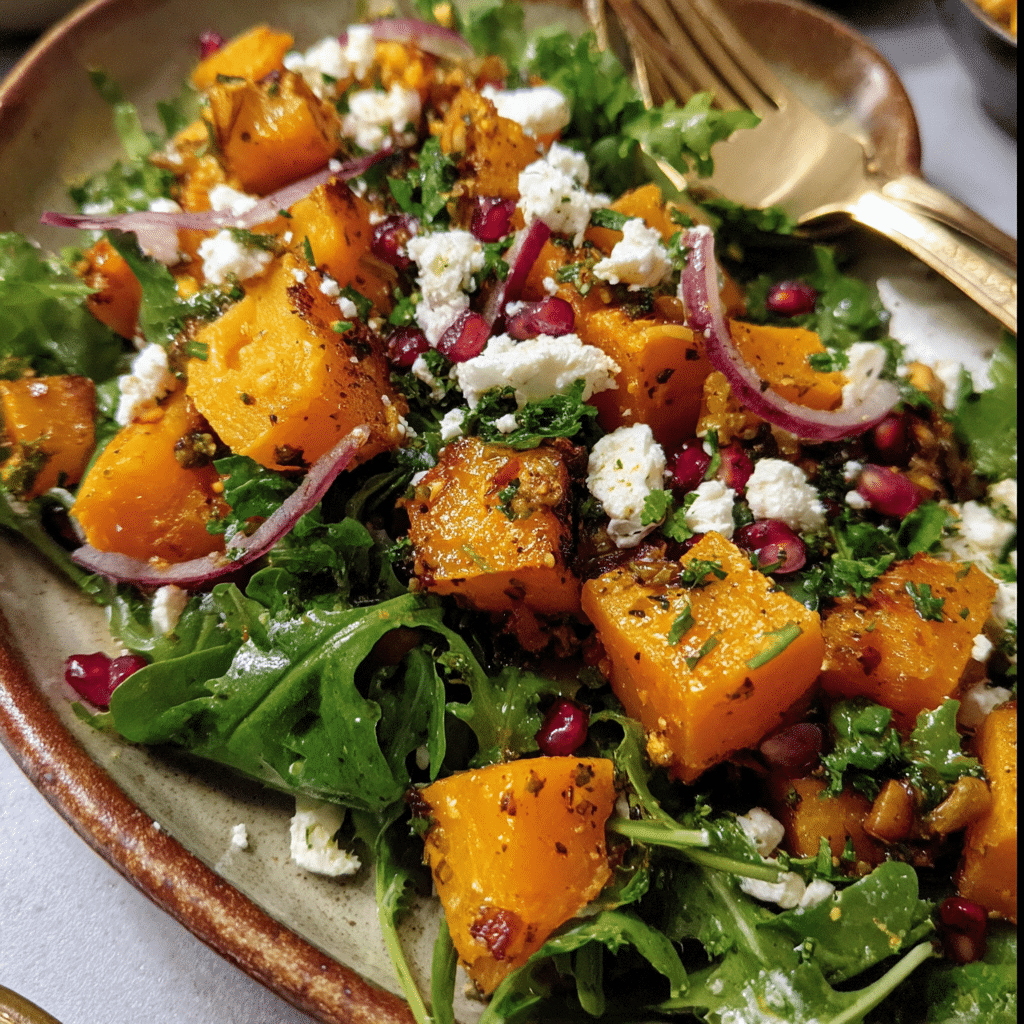
As I began experimenting in my kitchen, I discovered the beauty of combining roasted butternut squash with crumbled feta. The sweetness of the squash perfectly balanced the salty, creamy feta, creating a dish that was not only visually stunning but also packed with flavor. This salad quickly became a favorite among my family and friends, often requested at gatherings and potlucks. It was during these shared meals that I realized how food could bring people together, creating connections and memories that last a lifetime.
The Story Behind This Recipe
The origins of butternut squash feta can be traced back to the Mediterranean, where feta cheese is a staple in many dishes. Feta is traditionally made from sheep’s milk and has been enjoyed for centuries, particularly in Greek cuisine. The idea of pairing it with roasted vegetables, especially seasonal produce like butternut squash, has gained popularity in various culinary circles, especially among those seeking healthier, plant-based meals.
In my culinary journey, I have seen this dish evolve from a simple salad to a versatile side that can be adapted to different tastes and dietary needs. The beauty of butternut squash feta lies in its flexibility. You can add nuts for crunch, herbs for freshness, or even grains like quinoa for a more substantial meal. This adaptability makes it a go-to recipe for busy families looking for quick dinner solutions, as it can be prepared in advance or whipped up in a matter of minutes.
Why You’ll Love This Dish
What makes butternut squash feta so special is its seasonal relevance. As the leaves change and the air turns crisp, this dish embodies the essence of fall. It’s the perfect accompaniment to Thanksgiving dinner or a cozy weeknight meal, warming hearts and bellies alike. The vibrant colors of roasted squash and the bright white of feta create a stunning presentation that is sure to impress your guests.
Moreover, beyond its aesthetic appeal, butternut squash feta carries an emotional connection for me. It reminds me of family gatherings, laughter, and the joy of sharing a meal with loved ones. Each bite is a reminder of the importance of nurturing relationships through food. I promise that by the end of this guide, you will not only learn how to prepare a delicious butternut squash feta salad but also discover the deeper connections that food can forge.
The Rich History and Cultural Significance of butternut squash feta
The rich history and cultural significance of butternut squash feta stretch far beyond its ingredients. While it may seem like a modern culinary creation, its roots are intertwined with ancient traditions, regional variations, and an evolving appreciation for seasonal produce. To truly understand this dish, we must delve into its origins and the cultural context that has shaped its popularity.
Origins and History
Butternut squash, native to the Americas, has been cultivated for thousands of years. Indigenous peoples valued this nutritious vegetable, incorporating it into their diets long before it became a staple in contemporary cuisine. The squash was often roasted or used in soups, showcasing its versatility. Over time, as European settlers arrived, they brought with them their culinary traditions, including dairy farming. This led to the introduction of feta cheese to North America, where it has been embraced in various forms.
Feta cheese itself has a storied history, dating back to ancient Greece. It was traditionally made from sheep’s milk and was often aged in brine, giving it a distinctive tangy flavor. As culinary practices evolved, so did the methods of producing and enjoying feta. Today, it is widely available and celebrated for its ability to enhance a variety of dishes, including salads like butternut squash feta.
Cultural Significance
Butternut squash feta has become a favorite in modern culinary practices, particularly among health-conscious individuals and families. It embodies the farm-to-table movement, emphasizing the importance of using fresh, locally sourced ingredients. This salad is often served at gatherings, potlucks, and festive occasions, symbolizing abundance and community. In Mediterranean cultures, sharing meals with loved ones is a deeply ingrained tradition, and butternut squash feta fits perfectly into this narrative.
Chefs around the world have put their own spin on this dish, showcasing its adaptability. From upscale restaurants to home kitchens, it has become a canvas for creativity. Renowned chefs have highlighted the combination of roasted vegetables and creamy feta in their menus, emphasizing its appeal to those seeking both flavor and nutrition.
Nutritional Benefits
Beyond its cultural significance, butternut squash feta is also a nutritional powerhouse. Butternut squash is rich in vitamins A and C, promoting healthy skin and a robust immune system. It also provides a good source of dietary fiber, aiding in digestion. When combined with feta cheese, which is a source of protein and calcium, this salad becomes a well-rounded dish that can be enjoyed guilt-free.
As we explore the depths of butternut squash feta, we uncover not just a recipe, but a tapestry of history, culture, and health. Each bite of this salad tells a story of tradition and innovation, making it a dish that resonates with many. The next time you prepare butternut squash feta, remember that you are not just creating a meal; you are participating in a rich culinary legacy that continues to evolve and inspire.
Essential Ingredients for Perfect butternut squash feta
Creating a delightful butternut squash feta salad starts with understanding the essential ingredients that bring this dish to life. The combination of flavors, textures, and colors in a salad can elevate it from a simple side dish to a show-stopping centerpiece of your meal. Each ingredient in this salad plays a critical role, and knowing how to choose and handle them will ensure your salad is not only delicious but also visually appealing.
Essential Ingredients
- Butternut Squash: 1 medium-sized (about 2-3 pounds)
- Feta Cheese: 1 cup, crumbled
- Baby Spinach: 4 cups, fresh
- Red Onion: 1 small, thinly sliced
- Pomegranate Seeds: 1/2 cup (fresh or frozen)
- Walnuts: 1/2 cup, chopped (optional)
- Olive Oil: 3 tablespoons, extra virgin
- Balsamic Vinegar: 2 tablespoons
- Honey: 1 tablespoon (for sweetness)
- Salt and Pepper: to taste
The butternut squash is the star of this salad. It’s sweet and nutty, perfectly complementing the salty, tangy flavors of the feta cheese. When selecting butternut squash, look for one that feels heavy for its size and has a smooth, tan skin. Avoid any with soft spots or blemishes, as these may indicate spoilage. Seasonal availability for butternut squash typically peaks in the fall and winter, making it a great choice for hearty salads during cooler months.
Feta cheese adds a creamy texture and a burst of flavor that enhances the dish. When choosing feta, opt for blocks of feta rather than pre-crumbled varieties, as this will give you better flavor and freshness. Look for cheese that is white and crumbly with a slightly tangy aroma. Consider sourcing it from local dairies or farmers’ markets for the best quality.
Baby spinach is a wonderful base for this salad, providing a fresh, vibrant green color and a mild flavor. When shopping, choose leaves that are bright green with no wilting or discoloration. If you’re looking for a heartier green, you might also consider arugula or mixed baby greens.
The red onion adds a sharp bite that contrasts beautifully with the sweetness of the butternut squash. Choose a small onion with a firm texture and smooth skin. If you find raw onions too pungent, soaking them in cold water for 10 minutes before adding them to the salad can mellow their flavor.
Pomegranate seeds not only provide a burst of color but also a juicy sweetness that ties the flavors together. If fresh pomegranates are out of season, frozen pomegranate seeds work well, too. They are usually available all year round and can be found in the freezer section of most grocery stores.
Walnuts add a delightful crunch and a dose of healthy fats. When buying walnuts, look for ones that are in the shell, as they last longer. If you prefer a different nut, try pecans or almonds as substitutions; they will offer a similar crunch and flavor profile.
Print
Butternut Squash Feta Salad
Ingredients
For The Salad:
- 2 lbs. butternut squash cubed, equals 5-6 heaping cups
- 2 Tbsp. olive oil
- 1 tsp. smoked paprika
- 1 tsp. garlic powder
- ¼ tsp. kosher salt
- ¼ tsp. pepper
- 5 oz. hearty greens such as arugula, spinach, kale, or Swiss chard
- ¾ cup walnuts or nuts of choice
- ¾ cup feta cheese or cheese of choice
For The Dressing:
- 2 Tbsp. olive oil
- 2 Tbsp. lemon juice
- 1 Tbsp. Dijon mustard
- 1 Tbsp. maple syrup
- ¼ tsp. kosher salt
- pinch pepper
Instructions
- Heat oven to 400 degrees Fahrenheit.
- How To Peel and Cut The Butternut Squash:
- Remove the top and bottom of the squash with a sharp knife and discard in the compost or trash bin.
- Cut the butternut squash in half. Place each half, flat side down, on the cutting board. Carefully run the knife down the outer surface of each butternut squash half, or peel it with a vegetable peeler. Discard the skins in the compost or trash bin.
- Cut each half of the squash in half again. Scoop out the seeds and membranes from the bottom portion of the squash with a large spoon, just as you would a pumpkin. Discard the seeds and membranes.
- Cut each half of the squash into slices and then cut those slices into chunks. It’s important that the squash chunks are relatively the same size to ensure that they cook evenly.
- This recipe calls for 5-6 heaping cups of cubed butternut squash.
- For The Salad:
- Place the cubed butternut squash onto a large baking sheet. Drizzle 2 Tbsp. olive oil over the butternut squash and toss to coat. Alternately, you can spread the butternut squash out across two smaller baking sheets.
- Sprinkle 1 tsp. each smoked paprika and garlic powder, along with ¼ tsp. each kosher salt and pepper over the butternut squash. Toss until completely combined.
- Place the baking sheet in the oven and roast the butternut squash for 22-25 minutes, or until tender. Baking times may vary slightly.
- The squash should be tender, but not mushy, and easily pierced with a knife when done. Remove the pan when finished and set aside to cool.
- For The Dressing:
- Combine 2 Tbsp. olive oil, 2 Tbsp. lemon juice, 1 Tbsp. Dijon mustard, 1 Tbsp. maple syrup, ¼ tsp. kosher salt and a pinch of pepper in a small bowl.
- Whisk all of the ingredients together until combined using a small whisk or fork.
- For The Walnuts:
- Place a small cast iron skillet or small pan on the stove top. Pour ¾ cup of unsalted walnuts (or nuts of choice) into the pan.
- Heat to medium-low and toast the nuts for 5-6 minutes, stirring occasionally to prevent them from burning. Remove the pan from the heat after the walnuts are toasted.
- Assemble The Salad:
- Place 5 oz. of your favorite hearty greens (such as arugula, spinach, kale, or Swiss chard) in a large mixing bowl.
- Drizzle as much or as little of the dressing as you like over the salad and toss until completely coated.
- To Serve: Pour the dressed salad out onto a serving platter or into a large serving bowl. Place the cooled roasted butternut squash on top of the greens. Add the ¾ cup toasted walnuts and ¾ cup crumbled feta cheese on top of the salad.
Shopping Tips
When it comes to sourcing ingredients for your butternut squash feta salad, consider visiting local farmers’ markets. Not only do these markets often feature fresher produce, but they also encourage seasonal eating, which is more sustainable and generally more flavorful. If you’re aiming for organic ingredients, check for certification labels on produce, especially for items like spinach and walnuts, which can have higher pesticide residues.
Additionally, buying in bulk can save you money, especially for items like nuts and grains. Keep an eye out for sales or discounts at your local grocery stores, especially when they have a large supply of seasonal produce. This can help you stick to your budget while still enjoying high-quality ingredients for your salad.
Substitutions and Alternatives
If you have dietary restrictions or simply wish to experiment with alternatives, there are plenty of options. For a vegan version, substitute the feta cheese with a plant-based cheese or even avocado for creaminess. If you prefer not to use nuts, you can omit them entirely or replace them with seeds like pumpkin or sunflower seeds for added crunch without the allergen.
For those who may be gluten intolerant, this salad is naturally gluten-free, making it a great choice for gatherings. If you want to make the salad heartier, consider adding grains like quinoa or farro, which would pair wonderfully with the other ingredients.
When it comes to storage, keep each ingredient in its appropriate manner. Butternut squash can be stored in a cool, dry place for several weeks, while spinach should be kept in the refrigerator in a breathable container to maintain freshness. Feta cheese should also be refrigerated and consumed within a week or two for the best flavor and texture.
The butternut squash feta salad is a versatile dish that celebrates the best of seasonal produce while allowing for creativity in the kitchen. With the right ingredients and some thoughtful substitutions, you can create a salad that is not only delicious but also tailored to your tastes and dietary needs.
Detailed Step-by-Step butternut squash feta Cooking Instructions
Once you have gathered all the essential ingredients for your butternut squash feta salad, it’s time to dive into the cooking process. This salad is not only delicious but also beautifully colorful, making it a fantastic dish for any gathering or simply as a nutritious meal. Follow these detailed step-by-step instructions to achieve a perfectly balanced and flavorful salad.
Preparation Steps
- Preheat your oven: Start by preheating your oven to 400°F (200°C). This temperature is perfect for roasting the butternut squash, allowing it to caramelize and develop a rich flavor.
- Peel and cut the butternut squash: Using a sharp vegetable peeler, peel the skin off the butternut squash. Be sure to remove any strings or fibrous parts. Once peeled, cut the squash in half lengthwise and scoop out the seeds using a spoon. Cut the squash into 1-inch cubes for even roasting.
- Toss with olive oil: In a large bowl, combine the cubed butternut squash with 2 tablespoons of extra virgin olive oil, a pinch of salt, and black pepper. Toss until the cubes are evenly coated. This step is crucial as it adds flavor and helps the squash caramelize beautifully in the oven.
- Roast the squash: Spread the butternut squash cubes evenly on a baking sheet lined with parchment paper. Ensure they are not overcrowded; this helps them roast rather than steam. Roast in the preheated oven for about 25-30 minutes, or until the squash is tender and golden brown. You’ll know it’s ready when you can easily pierce it with a fork.
- Prepare the other ingredients: While the squash is roasting, thinly slice the red onion and chop the walnuts if you’re using them. Rinse the baby spinach under cold water and pat dry with a clean towel or use a salad spinner. This ensures that your salad remains fresh and crisp.
- Make the dressing: In a small bowl, whisk together the balsamic vinegar, honey, and the remaining tablespoon of olive oil. Adjust the seasoning with salt and pepper to taste. The dressing should balance the sweetness of the squash and pomegranate seeds with a hint of acidity.
Cooking Process
Once the butternut squash is roasted to perfection, it’s time to assemble the salad. This is where the magic happens!
- Combine the ingredients: In a large salad bowl, combine the roasted butternut squash, baby spinach, sliced red onion, pomegranate seeds, and crumbled feta cheese. If you’re using walnuts, add them at this stage as well.
- Toss gently: Using two large spoons or your hands, gently toss the salad until everything is evenly distributed. Be careful not to crush the feta cheese or squash; you want to maintain the integrity of each ingredient.
- Add the dressing: Drizzle the prepared dressing over the salad. Start with a little and add more to your taste. Toss the salad gently again, ensuring that every leaf is coated with the dressing.
- Serve immediately: This salad is best enjoyed fresh. Serve it on a large platter or in individual bowls. For an added touch, sprinkle some extra pomegranate seeds or walnuts on top just before serving for a pop of color and texture.
Final Assembly
As you prepare to serve your butternut squash feta salad, take a moment to appreciate the vibrant colors and enticing aromas. The combination of roasted butternut squash, bright pomegranate seeds, and the creamy feta cheese creates a visual feast that will surely impress your family and friends.
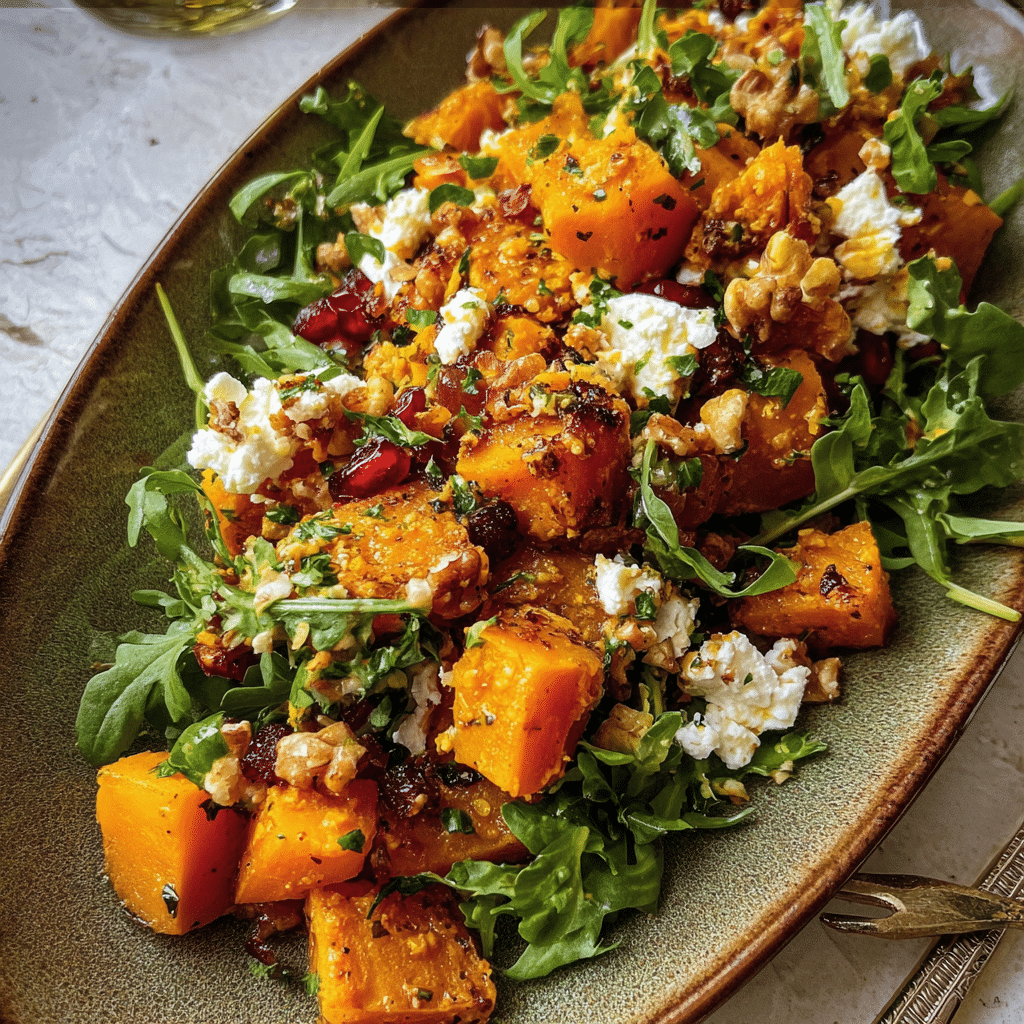
When it comes to serving, consider pairing this salad with grilled chicken or fish for a complete meal, or enjoy it as a standalone dish. The flavors meld beautifully, and it can even be made ahead of time. If you do prepare it in advance, keep the dressing separate until just before serving to maintain the freshness of the greens.
Common mistakes to avoid include overcooking the squash, which can lead to a mushy texture, and under-seasoning the salad, so taste as you go! Professional chefs often emphasize the importance of flavor balance, so don’t hesitate to adjust the seasoning to suit your palate.
In just about 30 minutes, you can create a stunning butternut squash feta salad that is not only delicious but also a testament to the beauty of seasonal ingredients. This dish is not only a treat for your taste buds but also a celebration of wholesome, vibrant food that nourishes both body and soul.
Professional Tips and Techniques for butternut squash feta
When it comes to creating a delicious butternut squash feta salad, the key is understanding the nuances of cooking with butternut squash and feta cheese. This combination not only offers a burst of flavor but also a delightful texture that elevates any meal. Here are some professional tips and techniques to ensure your salad turns out perfectly every time.
Professional Techniques
One of the most critical aspects of cooking with butternut squash is the preparation. Start by selecting a firm and heavy squash with smooth skin—this indicates freshness. To peel your butternut squash easily, consider using a vegetable peeler or a sharp knife. Cut the squash in half lengthwise and scoop out the seeds with a spoon. This method not only saves time but also reduces the risk of injury.
Next, when it comes to cooking the squash, roasting is a preferred method as it enhances the natural sweetness of the squash and adds a depth of flavor. Preheat your oven to 400°F (200°C). Cut the squash into 1-inch cubes, toss them in olive oil, salt, and pepper, and spread them out in a single layer on a baking sheet. Roasting for 25-30 minutes will yield perfectly caramelized pieces that blend beautifully with the feta cheese.
Another advanced technique for experienced cooks involves combining flavors through marination. Consider marinating roasted butternut squash in a mix of balsamic vinegar, garlic, and herbs before adding it to your salad. This not only enhances the flavor but also adds an aromatic layer that pairs wonderfully with the tangy feta.
Troubleshooting Guide
Even the most seasoned cooks can run into issues, so here are some common problems and their solutions. If your butternut squash is too mushy, it might be overcooked. To avoid this, monitor the cooking time closely and check for tenderness with a fork. For a salad, you want the squash to retain some firmness.
If your feta cheese seems too salty, consider rinsing it under cold water before crumbling it into your salad. This simple step can balance the flavors without compromising the dish. Additionally, if you find the salad lacks brightness, a squeeze of fresh lemon juice or a splash of apple cider vinegar can elevate the flavors significantly.
Presentation Tips
Presentation is key when serving your butternut squash feta salad. Use a large, shallow bowl to display the vibrant colors of the roasted butternut squash and the white feta. Layer the ingredients artfully, allowing the colors to shine. Garnish with fresh herbs like parsley or mint to add a pop of green and freshness.
Consider pairing your salad with complementary sides. A simple grilled chicken breast or a crusty piece of bread can round out the meal. When it comes to wine pairings, a light white wine such as Sauvignon Blanc or a dry rosé works wonderfully. The acidity in these wines complements the sweetness of the squash and the creaminess of the feta, creating a harmonious dining experience.
For meal prep enthusiasts, this salad can be made ahead of time. The roasted squash can be stored in an airtight container in the fridge for up to five days, while the feta can maintain its freshness for a week. Just toss everything together right before serving to keep the textures intact.
If you need to scale your recipe up for a larger gathering, simply multiply the quantities of your ingredients. However, be cautious with the olive oil and seasoning; it’s always best to start with less and adjust to taste.
Creative Variations and Adaptations of butternut squash feta
The beauty of a butternut squash feta salad lies in its versatility. You can easily adapt this dish to suit your tastes, dietary preferences, or seasonal ingredients. Here are some creative variations and adaptations to inspire your culinary adventures.
Seasonal Variations
As seasons change, so do the ingredients available to you. In the fall, consider adding roasted Brussels sprouts or pomegranate seeds for a burst of tartness and color. During winter, kale can be a hearty addition, providing a robust base that balances the sweetness of the squash.
In the spring and summer months, fresh herbs like basil or dill can bring a refreshing twist to your salad. You might also want to incorporate seasonal fruits such as apples or pears, which complement the squash and feta beautifully. These seasonal variations not only keep your salad exciting but also allow you to utilize fresh produce year-round.
Dietary Adaptations
For those following specific dietary lifestyles, the butternut squash feta salad can be tailored to fit your needs. If you’re looking for a keto-friendly option, you can replace the feta with crumbled goat cheese or omit the cheese altogether and add avocado for creaminess. For a vegan version, swap the feta with marinated tofu or chickpeas, which will provide protein and texture without dairy.
Gluten-free eaters can enjoy this salad without modifications as it naturally fits within a gluten-free diet. Additionally, if you want to spice things up, consider adding some diced jalapeños or a drizzle of sriracha for a kick. Adjusting the spice level can cater to your personal preference or the preferences of your guests.
Creative Twists
The method of cooking can also bring new life to your butternut squash feta salad. Instead of roasting, try sautéing the squash in a skillet with garlic and olive oil until tender. This method is quicker and still delivers a delicious flavor profile. Alternatively, using a slow cooker can allow the flavors to meld beautifully over time; simply add the squash, feta, and any additional ingredients to the slow cooker and let it work its magic.
Leftovers can also be transformed into a new dish. Consider blending any leftover salad into a creamy soup by adding vegetable broth and pureeing it until smooth. This way, you not only reduce food waste but also create a comforting, warm meal that still highlights the original ingredients.
Another fun idea is to turn your salad into a wrap. Use a large lettuce leaf or a whole grain tortilla to wrap the salad for a portable lunch option. The flavors meld beautifully, and you have a convenient meal on the go.
In conclusion, the butternut squash feta salad is a canvas for creativity and adaptation. Whether you’re embracing seasonal ingredients, modifying for dietary needs, or experimenting with cooking methods, there’s no limit to the delicious combinations you can create. So, roll up your sleeves, and let your culinary imagination run wild!
Storage, Reheating, and Meal Prep for butternut squash feta
When it comes to enjoying a delightful dish like butternut squash feta salad, proper storage is key to maintaining its vibrant flavors and crisp textures. Whether you’re making it for a special occasion or just for your weekly meal prep, knowing how to store, freeze, and reheat your salad can make all the difference. Let’s dive into the ins and outs of storing butternut squash feta salad, ensuring you can enjoy it at its best, even days later!
Short-term Storage
For short-term storage of your butternut squash feta salad, the refrigerator is your best friend. After preparing this colorful dish, allow it to cool to room temperature (but not for too long, as food safety is important). Transfer the salad into an airtight container; glass containers with tight-fitting lids are ideal because they prevent odors from other foods and help keep your salad crisp and fresh. I often use mason jars, which are not only pretty but also functional for storing portions of salads. Make sure to leave a little space at the top of your container since the ingredients may expand slightly as they chill.
In the refrigerator, your butternut squash feta salad can last for about 3 to 5 days. However, if your salad contains dressing, consider storing the dressing separately to prevent the salad from becoming soggy. I’ve made this mistake before, and while it still tastes good, the textures just aren’t the same. By keeping the dressing separate, you ensure that the vibrant colors and crunch of your veggies remain intact until you’re ready to dig in.
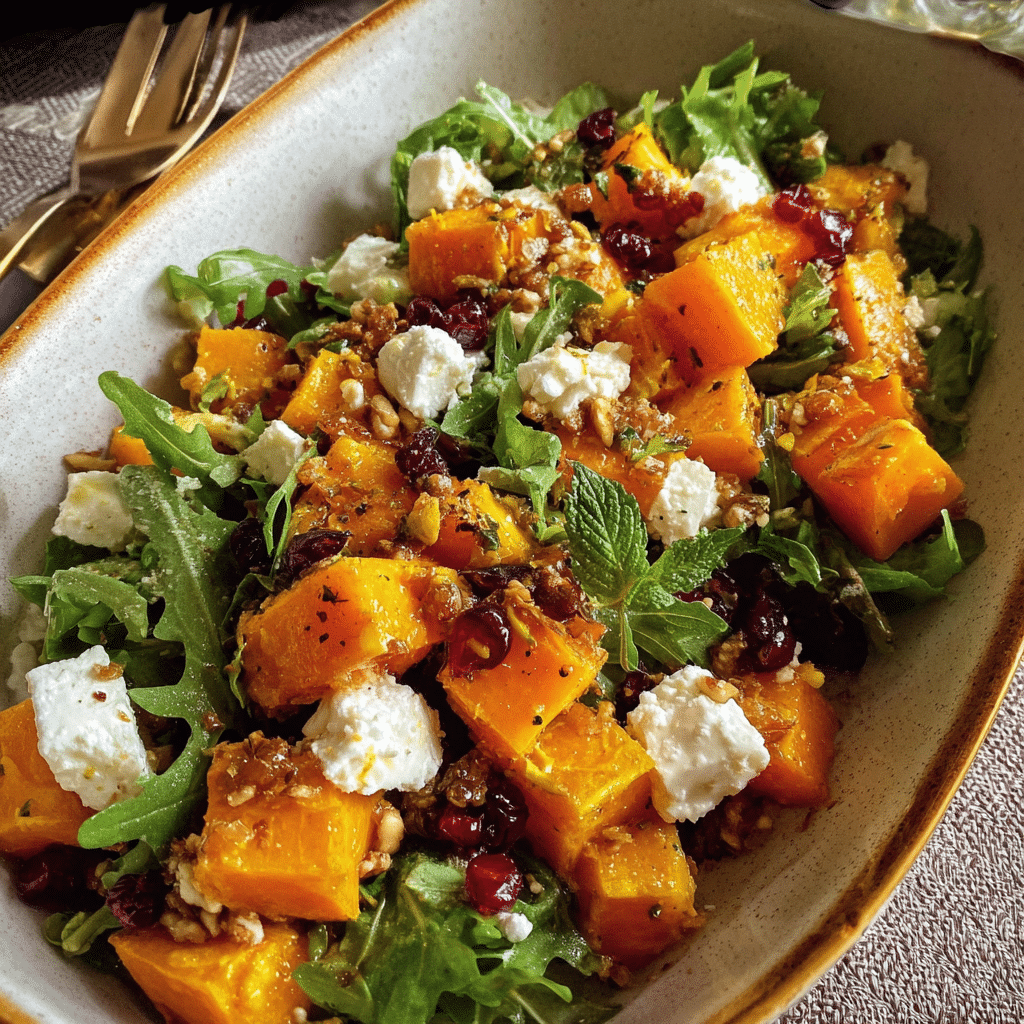
Freezing and Long-term Storage
Freezing a salad may sound unconventional, but it can be a great option if you’ve made a large batch of butternut squash feta salad and want to enjoy it later. However, not all salad ingredients freeze well. The feta cheese and fresh greens might become mushy upon thawing. Instead, I recommend freezing the roasted butternut squash cubes and any other hearty ingredients (like cooked grains, if you added them) separately.
To freeze butternut squash, first chop it into even cubes and roast them until tender. Allow the cubes to cool completely, then spread them out on a baking sheet lined with parchment paper. This step is crucial! It prevents the cubes from sticking together, allowing you to grab just the right amount later. Once they are frozen solid, transfer them to a freezer-safe bag or container, removing as much air as possible before sealing. Properly stored, frozen butternut squash can last up to 8 months.
When you’re ready to use your frozen butternut squash, simply remove the desired amount and thaw it in the refrigerator overnight, or you can toss it directly into salads or warm dishes from frozen. Just keep in mind that the texture may not be as crisp as freshly roasted squash, but it will still be delicious!
Reheating Best Practices
If you’ve stored your butternut squash feta salad in the refrigerator, reheating can be a delightful experience if done correctly. I recommend reheating only the squash and any grains you might have included, as fresh greens and feta are best enjoyed cold. For reheating, you can use the oven or microwave. If you choose the oven, preheat it to 350°F (175°C), place the squash on a baking sheet, and heat for about 10-15 minutes or until warmed through. This method helps retain that lovely roasted flavor and texture.
If you’re in a hurry, the microwave is a convenient option. Just place the squash in a microwave-safe bowl and heat in 30-second intervals, stirring in between to ensure even warming. Remember, the goal is just to warm, not to cook it further. Once heated, you can mix it back into your salad along with the cold feta and greens.
For meal prep enthusiasts, preparing your butternut squash feta salad ahead of time can save you precious moments during the week. Batch cooking is a fantastic strategy here. Roast a larger batch of butternut squash and prepare individual containers with the squash, feta, and other ingredients, leaving the dressing out until the meal is ready to be consumed. This way, you’ll have a fresh, easy meal ready to go! Just remember to label your containers with dates to ensure you consume them within the recommended timeframes.
Food safety is always a priority in the kitchen. If your butternut squash feta salad has been left out at room temperature for more than two hours, it’s best to discard it. When reheating, ensure the squash reaches an internal temperature of 165°F (74°C) to ensure any bacteria are effectively eliminated. Following these guidelines will help you enjoy your butternut squash feta salad safely and deliciously.
In summary, whether you’re enjoying your salad fresh or storing it for later, the key is understanding how to properly store and reheat your butternut squash feta salad. With these tips, you can savor every bite, whether it’s a quick lunch or a delightful dinner.
Nutritional Benefits and Health Information
As we explore the delicious world of butternut squash feta salad, it’s not just a feast for the senses; it also offers a wealth of nutritional benefits. This salad is a perfect example of how healthy eating can be both enjoyable and satisfying. Let’s delve into the nutritional aspects of this vibrant dish, highlighting the health benefits of its key ingredients and how they contribute to your overall well-being.
Nutritional Profile
At its core, a butternut squash feta salad combines several nutrient-dense ingredients: roasted butternut squash, tangy feta cheese, fresh greens, nuts or seeds, and a dressing that often includes olive oil, lemon juice, or balsamic vinegar. Together, these elements create a balanced meal that is rich in vitamins, minerals, and other essential nutrients. One serving of this salad typically contains around 250-350 calories, depending on the portion sizes and additional ingredients.
Butternut squash is the star of the show, and for good reason! A 1-cup serving of cooked butternut squash contains about 82 calories, 22 grams of carbohydrates, and 2 grams of protein. It’s also loaded with beta carotene, which your body converts into vitamin A, crucial for maintaining healthy vision, skin, and immune function. In addition, butternut squash provides a significant amount of vitamin C, which supports the immune system and skin health, and potassium, which helps regulate blood pressure.
Feta cheese, while adding a creamy texture and salty flavor, also contributes to the nutritional profile. A 1-ounce serving of feta cheese contains approximately 75 calories, 6 grams of protein, and is a good source of calcium, which is essential for bone health. While feta does have a higher sodium content, using it in moderation can enhance flavor without compromising health.
Health Benefits
Beyond the individual nutrients, the combination of ingredients in butternut squash feta salad offers impressive health benefits. The fiber from the squash and greens helps to promote digestive health and can aid in weight management by keeping you feeling full longer. A diet rich in fiber is also linked to lower risks of heart disease and diabetes.
The healthy fats found in olive oil, often used in dressings, can support heart health by reducing bad cholesterol levels. Moreover, the antioxidants present in butternut squash and greens combat oxidative stress, potentially lowering the risk of chronic diseases.
One of my favorite aspects of this salad is its versatility; it can easily be tailored to fit various dietary needs. Need a gluten-free option? Simply omit any grains. Want to up the protein? Add chickpeas or grilled chicken. The possibilities are endless, allowing you to enjoy this dish while meeting your nutritional goals.
Dietary Considerations
While butternut squash feta salad is generally healthy for most people, it’s essential to consider any dietary restrictions or allergies. For those who are lactose intolerant or have a dairy allergy, feta cheese can be substituted with a dairy-free alternative or omitted entirely. The salad remains flavorful with the rich sweetness of the roasted squash and the crunch of fresh greens.
Additionally, those on low-carb diets might want to watch their portions of butternut squash, as it does contain carbs. However, incorporating it in moderation can still allow for a balanced intake while enjoying its nutritional benefits. I’ve found that even when I’m trying to cut back on carbs, a small serving of butternut squash adds a satisfying sweetness that complements the flavors beautifully without derailing my diet.
The balance of macronutrients in butternut squash feta salad makes it an ideal choice for various eating plans, including Mediterranean diets, paleo diets, and even plant-based lifestyles when adjusted accordingly. With its abundance of vitamins, minerals, and health-promoting properties, this salad is more than just a side dish; it’s a powerhouse of nutrition that can support your health goals.
In conclusion, butternut squash feta salad is not only a delightful culinary creation but also a nutritional powerhouse. Its ingredients work synergistically to provide a range of health benefits, making it a fantastic choice for anyone looking to eat healthily without compromising on flavor. So the next time you prepare this vibrant salad, remember that you’re not just enjoying a meal; you’re nourishing your body with every delicious bite!
Frequently Asked Questions About Butternut Squash Feta
Simple butternut squash feta salad side dish recipes
A simple butternut squash feta salad can be made by roasting cubed butternut squash until tender, then tossing it with crumbled feta cheese and a handful of fresh spinach or arugula. For added flavor, drizzle the salad with olive oil and a squeeze of lemon juice. You can also incorporate toasted nuts, such as walnuts or pecans, for a delightful crunch. This dish pairs well with grilled meats or can serve as a light lunch on its own. To keep it simple, focus on high-quality ingredients that enhance the natural sweetness of the squash.
Easy butternut squash feta salad side dish recipes
For an easy butternut squash feta salad, consider using pre-cut butternut squash to save time. Simply roast the squash with olive oil, salt, and pepper until golden brown. Once cooked, combine it with crumbled feta, chopped fresh herbs like parsley or mint, and a handful of dried cranberries for a touch of sweetness. To give it a zesty kick, a balsamic vinaigrette or a simple lemon dressing can elevate the flavors. This salad not only looks appealing but also offers a satisfying combination of textures and tastes.
Ottolenghi butternut squash feta salad
The Ottolenghi butternut squash feta salad is renowned for its bold flavors and vibrant presentation. To recreate this dish, start by roasting butternut squash with spices such as cinnamon and cumin for an aromatic base. Once cooled, mix it with crumbled feta, pomegranate seeds, and fresh herbs like cilantro or parsley. A drizzle of tahini dressing adds creaminess and depth to the salad. For an authentic Ottolenghi touch, serve it with a side of warm pita bread to soak up the delicious flavors.
Butternut squash feta salad side dish recipes healthy
To create a healthy butternut squash feta salad, focus on incorporating a variety of fresh vegetables alongside the squash. Start by roasting butternut squash and mixing it with leafy greens such as kale or spinach, which are rich in nutrients. Add in sliced cherry tomatoes and cucumber for a refreshing crunch, along with crumbled feta for protein. Opt for a homemade vinaigrette made with olive oil, apple cider vinegar, and a dash of mustard to keep the dressing light. This salad is not only nutritious but also satisfying, making it perfect for a wholesome side dish or a light meal.
Conclusion: Mastering the Perfect butternut squash feta
Creating the perfect butternut squash feta is more than just following a recipe—it’s about understanding the techniques, ingredients, and cultural significance behind this beloved dish. Throughout this comprehensive guide, we’ve explored everything from the historical origins to modern variations, ensuring you have all the knowledge needed to make this recipe your own.
Whether you’re a beginner cook or an experienced chef, the techniques and tips we’ve shared will help you create a butternut squash feta that’s not only delicious but also meaningful. Remember that cooking is a journey of discovery, and each time you make this dish, you’ll learn something new.
We encourage you to experiment with the variations we’ve discussed, adapt the recipe to your dietary needs, and most importantly, share it with the people you love. Food has the incredible power to bring people together, and Butternut Squash Feta Salad is the perfect dish to create lasting memories around your dinner table.

